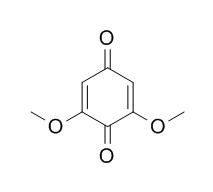2,6-Dimethoxy-1,4-benzoquinone
2,6-Dimethoxy-1,4-benzoquinone exhibits strong antibacterial activities against S. pyogenes, S. mitis, and S. mutans with MIC values of 7.8, 7.8, and 15.6 ug/mL, and MBC values of 7.8, 7.8, and 31.2 ug/mL, respectively. 2,6-Dimethoxy-1,4-benzoquinone can produce genotoxic effects in patients taking dimethophrine.
Inquire / Order:
manager@chemfaces.com
Technical Inquiries:
service@chemfaces.com
Tel:
+86-27-84237783
Fax:
+86-27-84254680
Address:
1 Building, No. 83, CheCheng Rd., Wuhan Economic and Technological Development Zone, Wuhan, Hubei 430056, PRC
Providing storage is as stated on the product vial and the vial is kept tightly sealed, the product can be stored for up to
24 months(2-8C).
Wherever possible, you should prepare and use solutions on the same day. However, if you need to make up stock solutions in advance, we recommend that you store the solution as aliquots in tightly sealed vials at -20C. Generally, these will be useable for up to two weeks. Before use, and prior to opening the vial we recommend that you allow your product to equilibrate to room temperature for at least 1 hour.
Need more advice on solubility, usage and handling? Please email to: service@chemfaces.com
The packaging of the product may have turned upside down during transportation, resulting in the natural compounds adhering to the neck or cap of the vial. take the vial out of its packaging and gently shake to let the compounds fall to the bottom of the vial. for liquid products, centrifuge at 200-500 RPM to gather the liquid at the bottom of the vial. try to avoid loss or contamination during handling.
Cell Mol Biol(Noisy-le-grand)2019, 65(7):77-83
Molecules.2023, 28(8):3503.
Applied Food Research2024, 100662.
Biomol Ther (Seoul).2023, 31(1):40-47.
Pharmaceutics.2020, 12(9):845.
Int J Mol Sci.2022, 23(5):2796.
Nutrients2022, 14(3),695.
Biomolecules.2024, 14(10):1257.
Plants (Basel).2021, 10(5):951.
J Ethnopharmacol.2017, 209:305-316
Related and Featured Products
Pharm Biol. 2014 Sep;52(9):1104-9.
Antimicrobial activities of some Thai traditional medical longevity formulations from plants and antibacterial compounds from Ficus foveolata.[Pubmed:
24611777]
Medicinal plants involved in traditional Thai longevity formulations are potential sources of antimicrobial compounds.
To evaluate the antimicrobial activities of some extracts from medicinal plants used in traditional Thai longevity formulations against some oral pathogens, including Streptococcus pyogenes, Streptococcus mitis, Streptococcus mutans, and Candida albicans. An extract that possessed the strongest antimicrobial activity was fractionated to isolate and identify the active compounds.
METHODS AND RESULTS:
Methanol and ethyl acetate extracts of 25 medicinal plants used as Thai longevity formulations were evaluated for their antimicrobial activity using disc diffusion (5 mg/disc) and broth microdilution (1.2-2500 µg/mL) methods. The ethyl acetate extract of Ficus foveolata Wall. (Moraceae) stems that exhibited the strongest antibacterial activity was fractionated to isolate the active compounds by an antibacterial assay-guided isolation process.
The ethyl acetate extract of F. foveolata showed the strongest antibacterial activity with minimum inhibitory concentration (MIC) and minimum bactericidal concentration (MBC) values of 19.5-39.0 and 39.0-156.2 µg/mL, respectively. On the basis of an antibacterial assay-guided isolation, seven antibacterial compounds, including 2,6-Dimethoxy-1,4-benzoquinone (1), syringaldehyde (2), sinapaldehyde (3), coniferaldehyde (4), 3β-hydroxystigmast-5-en-7-one (5), umbelliferone (6), and scopoletin (7), were purified.
CONCLUSIONS:
Among these isolated compounds, 2,6-Dimethoxy-1,4-benzoquinone (1) exhibited the strongest antibacterial activities against S. pyogenes, S. mitis, and S. mutans with MIC values of 7.8, 7.8, and 15.6 µg/mL, and MBC values of 7.8, 7.8, and 31.2 µg/mL, respectively. In addition, this is the first report of these antibacterial compounds in the stems of F. foveolata.
Farmaco Sci. 1988 Jun;43(6):523-38.
Formation of 2,6-dimethoxy-1,4-benzoquinone, a highly genotoxic compound, from the reaction of sodium nitrite with the sympathomimetic drug dimethophrine in acidic aqueous solution.[Pubmed:
3208895]
Because of the genotoxic effects shown by Dimethophrine (DMP) nitrosation mixtures, the interaction between DMP hydrochloride and sodium nitrite in acidic aqueous solution at 37 degrees was investigated in a wide range of reagent concentrations and molar ratios, reaction times and pH values.
METHODS AND RESULTS:
Actually, depending on the operating conditions, it was possible to detect variable amounts of 2,6-Dimethoxy-1,4-benzoquinone (DMBQ), a highly genotoxic compound, but no N-nitrosoderivative. The highest conversion of DMP into DMBQ was obtained when concentrated acidic solutions of DMP and NaNO2 (molar ratio 1:1.9) reacted at pH 3.0-4.0 (50-60% after 1 hour, depending on the pH conditions). When DMP hydrochloride and NaNO2 (molar ratio 1:0.95) were allowed to react at pH 3.5 in a more diluted solution, to mimic gastric conditions, the conversion of DMP into DMBQ after 20 min was about 3%. The breakdown of DMP can be prevented by adding suitable amounts of ascorbic acid to the reagents.
J Pharmacol Exp Ther. 1988 Mar;244(3):1011-5.
Cytotoxic, DNA-damaging and mutagenic properties of 2,6-dimethoxy-1,4-benzoquinone, formed by dimethophrine-nitrite interaction.[Pubmed:
3252018]
In conditions similar to those occurring in the stomach, the sympathomimetic drug dimethophrine was found to react with nitrite yielding 2,6-Dimethoxy-1,4-benzoquinone (DMBQ).
METHODS AND RESULTS:
The in vitro and in vivo studies carried out to evaluate the capability of 2,6-Dimethoxy-1,4-benzoquinoneto produce cytotoxic and genotoxic effects provided the following results. A dose-related reduction of V79 cells plating efficiency was observed for 2,6-Dimethoxy-1,4-benzoquinone concentrations ranging from 10 to 80 microM; a similar reduction in the fraction of viable cells excluding trypan blue occurred after exposure to 4-fold higher concentrations. A dose-dependent amount of DNA fragmentation was revealed by the alkaline elution technique either in V79 cells exposed to 2,6-Dimethoxy-1,4-benzoquinone concentrations ranging from 10 to 80 microM or in kidney, gastric mucosa and brain of rats treated with single p.o. doses ranging from 33 to 300 mg/kg. Both in vitro and in vivo DNA lesions were largely repaired within 24 hr, but their promutagenic character was demonstrated by the induction of 6-thioguanine-resistance in V79 cells. Primary cultures of rat hepatocytes displayed a greater resistance to the cytotoxic and DNA-damaging activities of 2,6-Dimethoxy-1,4-benzoquinone, and did not exhibit a clear evidence of DNA repair synthesis. Similarly, DNA fragmentation was practically undetectable in the rat liver. Therefore, 2,6-Dimethoxy-1,4-benzoquinone should be considered as a direct-acting genotoxic chemical which is metabolized to less, or nonreactive, species.
CONCLUSIONS:
These findings suggest that 2,6-Dimethoxy-1,4-benzoquinone could produce genotoxic effects in patients taking dimethophrine.



